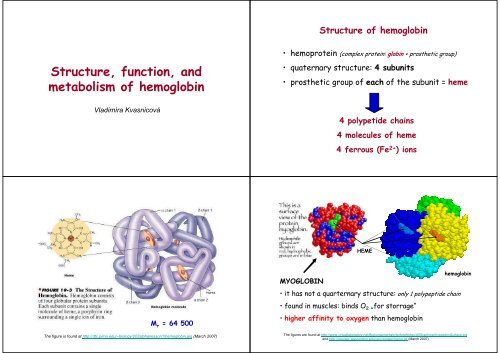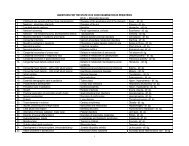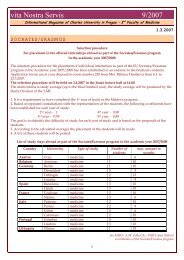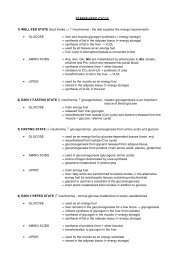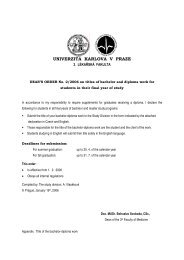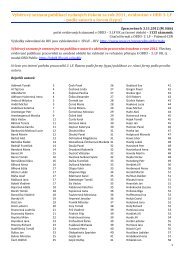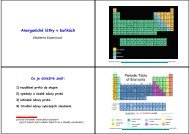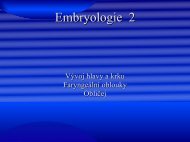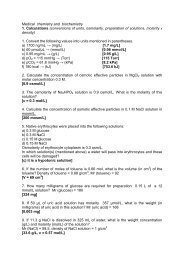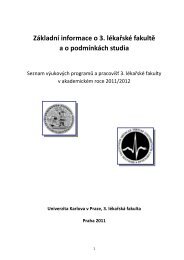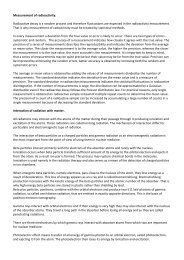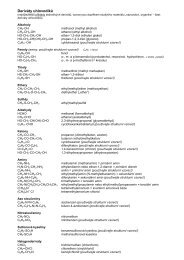Structure, function, and metabolism of hemoglobin
Structure, function, and metabolism of hemoglobin
Structure, function, and metabolism of hemoglobin
You also want an ePaper? Increase the reach of your titles
YUMPU automatically turns print PDFs into web optimized ePapers that Google loves.
<strong>Structure</strong> <strong>of</strong> <strong>hemoglobin</strong><strong>Structure</strong>, <strong>function</strong>, <strong>and</strong><strong>metabolism</strong> <strong>of</strong> <strong>hemoglobin</strong>Vladimíra Kvasnicová• hemoprotein (complex protein: globin + prosthetic group)• quaternary structure: 4 subunits• prosthetic group <strong>of</strong> each <strong>of</strong> the subunit = heme4 polypetide chains4 molecules <strong>of</strong> heme4 ferrous (Fe 2+ ) ionsHEMEMYOGLOBIN<strong>hemoglobin</strong>M r = 64 500The figure is found at http://dtc.pima.edu/~biology/202alpha/lesson1/<strong>hemoglobin</strong>.jpg (March 2007)• it has not a quarternary structure: only 1 polypeptide chain• found in muscles: binds O 2 „for storrage“• higher affinity to oxygen than <strong>hemoglobin</strong>The figures are found at http://www.virtuallaboratory.net/Bi<strong>of</strong>undamentals/lectureNotes/AllGraphics/myoglobinSurface.jpg<strong>and</strong> http://courses.washington.edu/conj/protein/hemo.gif (March 2007)
Types <strong>of</strong> <strong>hemoglobin</strong> <strong>and</strong> its subunits• adult <strong>hemoglobin</strong>:HbA 1 = α 2 β 2HbA 2 = α 2 δ 2(∼ 2% from total Hb <strong>of</strong> adults)• fetal <strong>hemoglobin</strong>HbF = α 2 γ 2 ! higher affinity to O 2 than HbA !binds oxygen more firmly at lower pO 2 (placenta!)The figure is found at http://www.labcorp.com/datasets/labcorp/html/img/fethgb.jpg (March 2007)<strong>Structure</strong> <strong>of</strong> hemePyrrole• cyclic tetrapyrrole• the pyrrols has different substituents• belongs among porphyrins (heme = Fe-protoporphyrine IX)• it contains: conjugated double bonds → red color 4 nitrogen atoms (N) 1 ferrous ion (Fe 2+ )→ in the middle <strong>of</strong> the tetrapyrrole structureby coordination-covalent bonds<strong>hemoglobin</strong>The figures are found at http://www.medical-definitions.net/images/<strong>hemoglobin</strong>.jpg<strong>and</strong> http://omlc.bme.ogi.edu/spectra/<strong>hemoglobin</strong>/hemestruct/heme-struct.gif (March 2007)
PyrroleQiuz1. What is the concentration <strong>of</strong> Hbin blood?2. Describe the structure <strong>of</strong> Hb3. Where is oxygen bound into Hb?4. How many O 2 can be bound to Hb?5. Draw the saturation curve <strong>of</strong> HbThe figures are found at http://www.medical-definitions.net/images/<strong>hemoglobin</strong>.jpg<strong>and</strong> http://omlc.bme.ogi.edu/spectra/<strong>hemoglobin</strong>/hemestruct/heme-struct.gif (March 2007)Synthesis <strong>of</strong> <strong>hemoglobin</strong>• bone marrow• in erytroblasts, not in erythrocytes• 4 individual subunits are connected bynoncovalent bonds to form tetramer <strong>of</strong> Hb• <strong>hemoglobin</strong> is an intracellular protein: within eryconcentration <strong>of</strong> Hb in blood:femalemale120 – 162 g/l135 – 172 g/l
Disorders:Synthesis <strong>of</strong> <strong>hemoglobin</strong>• THALASSEMIA = group <strong>of</strong> genetically determineddisorders: absence or reduced synthesis <strong>of</strong> a globin chain(α or β thalassemia)• ANEMIA (= decreased oxygen-carrier capacity <strong>of</strong> blood) sideropenic anemia – insufficient concentration <strong>of</strong> Fe sickle cell anemia – point mutationin the β-globin gene forms abnormalHbS (Glu → Val)Synthesis <strong>of</strong> heme - REPETITION• mainly in the bone marrow (Hb) <strong>and</strong> in the liver(cytochroms)• mitochondria / cytoplasm / mitochondria• substrates: succinyl-CoA + glycine• important intermediates: δ-aminolevulinic acid (= 5-aminolevulinic, ALA) porphobilinogen (PBG = pyrrol derivative) uroporphyrinogen III (= 1 st porphyrinogen – precursor <strong>of</strong> heme) protophorphyrine IX (= direct precursor <strong>of</strong> heme)Synthesis <strong>of</strong> heme - regulationALA-synthase the key regulatory enzyme in all tissues pyridoxal phosphate dependent (vit. B6)ALA-synthase 1 (liver) inhibited by heme (feed back inhibition) regulation <strong>of</strong> transcription <strong>and</strong> by allosteric mechanismThe figure is from: Color Atlas <strong>of</strong> Biochemistry / J. Koolman, K.H.Röhm. Thieme 1996. ISBN 0-86577-584-2 some drugs ↑ amount <strong>of</strong> ALA-synthase (↓ conc. <strong>of</strong> heme)ALA-synthase 2 (erythroblasts) neither feed back inhibition nor induction by drugs regulated on the level <strong>of</strong> iron availability
Disorders <strong>of</strong> hemesynthesisPORPHYRIAS• inborn or acquired• classification by defect enzyme• accumulation <strong>of</strong> heme precursors in the body(skin) <strong>and</strong> their excretion with urine or feaces(dark color)• neurogical symptomps, photosensitivitylead poisoning – accumulation <strong>of</strong> ALA (blood, urine)(inhibition <strong>of</strong> porphobilinogen synthase)Degradation <strong>of</strong> <strong>hemoglobin</strong>• cells <strong>of</strong> reticulo-endothelial system (RES) <strong>of</strong>spleen, bone marrow, liver, <strong>and</strong> skin• Hb released from erythrocytes in blood vesels isbound by haptoglobin→RES• free heme is transported by hemopexinHEMOGLOBIN → 4x globin + 4x heme• globins chains → amino acids• heme→Fe 3+ + CO + biliverdin→bile pigments→feacesQiuz1. Where is Hb synthesized?2. What failures <strong>of</strong> Hb synthesis do youknow?3. What substrates are needed for thesynthesis <strong>of</strong> heme?4. What is the source <strong>of</strong> iron for thesynthesis <strong>of</strong> heme?5. What is the cause <strong>of</strong> jaundice during anexcessive degradation <strong>of</strong> erytrocytes?The figure is from: Color Atlas <strong>of</strong> Biochemistry / J. Koolman, K.H.Röhm. Thieme 1996. ISBN 0-86577-584-2
Transport <strong>of</strong> blood gasesAir composition:78% N 2 21% O 2 1% water, inert gases, CO 2 (0,04%)Air pressure:1 atm = 101 325 Pa (~ 101 kPa) = 760 Torr (= mmHg)1 mmHg = 0,1333 kPa1 kPa = 7,5 mmHgTransport <strong>of</strong> blood gasesarterial blood venose bloodpO 2 13,33 kPa 5,33 kPa100 mmHg 40 mmHgpCO 2 5,33 kPa 6,13 kPa40 mmHg 46 mmHg(alveols)Transport <strong>of</strong> blood gases- <strong>function</strong> <strong>of</strong> <strong>hemoglobin</strong> -• it transports O 2 <strong>and</strong> part <strong>of</strong> CO 2 (<strong>and</strong> CO)• it binds H + (reacts as a buffer)• O 2 <strong>and</strong> CO: bound to Fe 2+ in heme → 4 O 2 / 1 Hb„oxy<strong>hemoglobin</strong>“ HbO 2 /„carbonyl<strong>hemoglobin</strong>“ COHb• CO 2 is bound to globin! (-NH 2 <strong>of</strong> side chains <strong>of</strong> amino acids)„carbamino<strong>hemoglobin</strong>“ HbCO 2The figure is found at http://people.eku.edu/ritchisong/RITCHISO//301notes6.htm (March 2007)• H + is bound to residues <strong>of</strong> His„deoxy<strong>hemoglobin</strong>“ HHb
Transport <strong>of</strong> blood gases- transport <strong>of</strong> CO 2 -1. largely in a form <strong>of</strong> HCO 3- (~ 70%)CO 2 + H 2 O ↔ H 2 CO 3 ↔ HCO 3- + H +enzyme: carbonic anhydrase spontaneous dissociation(in erytrocytes)2. bound to <strong>hemoglobin</strong> (~ 23%)3. freely dissolved (~ 7%)The figure is found at http://fig.cox.miami.edu/~cmallery/150/physiol/sf41x11.jpg (March 2007)Transport <strong>of</strong> blood gases- reactions in erytrocytes -O 2tissues:CO 2 + H 2 O → H 2 CO 3 → HCO 3- + H +H + + HbO 2 → HHb + O 2 → aerobic <strong>metabolism</strong>lungs:HHb + O 2 → HbO 2 + H +O 2H + + HCO 3- → H 2 CO 3 → H 2 O + CO 2 → excretedThe figure is from http://science.kennesaw.edu/~jdirnber/Bio2108/Lecture/LecPhysio/42-29-BloodCO2Transport-AL.gif (March 07)
Hemoglobin saturation curve- saturation with oxygen -The figure is found at http://employees.csbsju.edu/hjakubowski/classes/ch331/bind/MbHbbindcurve.gif(March 2007) The figure is found at http://dr-amy.com/rich/oxygen/fig1.gif (March 2007)HbF is left-shifted(it has higher affinity to oxygen)The figure is found at http://dr-amy.com/rich/oxygen/fig1.gif (March 2007)The figure is found at http://www.biocrawler.com/encyclopedia/Fetal_<strong>hemoglobin</strong> (March 2007)
Saturation <strong>of</strong> <strong>hemoglobin</strong> by oxygen• quaternary structure <strong>of</strong> <strong>hemoglobin</strong>allosteric effectT-conformation: lower affinity to O 2 (deoxy Hb)R-conformation: higher affinity to O 2 (oxyHb)T ↔ RHb + O 2 ↔ HbO 2The figure is found at http://employees.csbsju.edu/hjakubowski/classes/ch331/bind/MbHbbindcurve.gif (March 2007)Saturation <strong>of</strong> <strong>hemoglobin</strong> with oxygenFactors affecting the saturation: alkaline pH <strong>and</strong> ↑ pO 2 stabilize R-conformation(IN LUNGS) acidic pH, ↑ pCO 2 , ↑ temperature <strong>and</strong> 2,3-BPGstabilize T-conformation, i.e. deoxyHb(IN PERIPHERY)The animation is found at http://en.wikipedia.org/wiki/Image:Hb-animation2.gif (March 2007)shift <strong>of</strong> the saturation curve toward right
Bohr´s effect= the saturation <strong>of</strong> Hb by O 2 drops because lowering pHThe figure is found at http://employees.csbsju.edu/hjakubowski/classes/ch331/bind/MbHbbindcurve.gif(March 2007)The figure is found at http://www.nd.edu/~aseriann/dpg.html (March 2007)Qiuz1. What is the % proportion <strong>of</strong> O 2<strong>and</strong> CO 2 in air?2. What is pO 2 in arterial blood?3. What is pCO 2 in arterial blood?4. How is CO 2 transported in thehuman body?5. Summarize factors decreasingthe affinity <strong>of</strong> Hb to oxygenPatological forms <strong>of</strong> <strong>hemoglobin</strong>1. met<strong>hemoglobin</strong> (over 3%) metHb Fe 3+ instad <strong>of</strong> Fe 2+ unable to transport oxygen !!!2. glyco<strong>hemoglobin</strong> (over 6%) HbA 1c after long term increased glycemia3. carbonyl<strong>hemoglobin</strong> (over 2%) COHb after CO poisoning4. sulf<strong>hemoglobin</strong>, cyan<strong>hemoglobin</strong> poisoning by H 2 S, HCN or by cyanides
QiuzCarbon monoxide poisoning1. Compare the fetal <strong>and</strong> adult Hb2. What is met<strong>hemoglobin</strong>?3. What is glyco<strong>hemoglobin</strong>?4. What is carbonyl<strong>hemoglobin</strong>?5. What is carboxy<strong>hemoglobin</strong>?• CO has 200x higher affinity to Hb than O 2• it forms COHb = carbonyl <strong>hemoglobin</strong>(formerly called carboxy<strong>hemoglobin</strong>)• max. allowed concentration in the air: 0.003%• intoxication by CO depends on pCO <strong>and</strong> a time<strong>of</strong> its exposition (0.04% ∼ strong headache, 2-3 hours:unconsciousness; 1% ∼ death after a few minutes)CO bindsto Fe 2+ instead <strong>of</strong>oxygenThe figure is found at http://www.orthosmoke.org/index.php/pt/Carbon%20Monoxide (March 2007)The figure is found at http://dr-amy.com/rich/oxygen/fig1.gif (March 2007)
Carbon monoxide poisoningmay result due to:• exposure to automobile exhaust• smoke inhalation• an improperly ventilated gas heater• or other appliance (incomplete burning)CONSEQUENCESCarbon monoxide poisoning• decreased oxygen-carrying capacity <strong>of</strong> Hb• decreased delivery <strong>of</strong> oxygen to cells CO prevents reversible displacement <strong>of</strong> O 2 on Hb CO shifts the O 2 -<strong>hemoglobin</strong> dissociation curveto the left CO inhibits the intracellular respiration CO may bind directly to cardiac <strong>and</strong> skeletal muscleto cause direct toxicity <strong>and</strong> to components <strong>of</strong> thenervous system to cause demyelination <strong>and</strong> neurologicsymptomsSaturation <strong>of</strong><strong>hemoglobin</strong>with COCOHb / total Hb(ratio in %)physiological value:< 2%„cherry red coloration to the skin“The figure is found at http://www.acsu.buffalo.edu/~lcscott/carbonmonoxide.html (March 2007)The figure is found athttp://www.uhseast.com/134221.cfm(March 2007)
QiuzDescribe the first aid in case <strong>of</strong> anintoxication <strong>of</strong> a person bycarbon monoxideThe figure is from http://www.coheadquarters.com/CORisk/figco32x.htm (March 2007)Carbon monoxide poisoningTREATEMENT• fresh air• exposure to high concentrations <strong>of</strong> oxygen(the 100% oxygen is administered by a face mask) it is recommended in patients who have a history<strong>of</strong> loss <strong>of</strong> consciousness, carbonyl <strong>hemoglobin</strong>saturation greater than 25%, metabolic acidosis<strong>and</strong> cerebellar findings on neurologic exam


